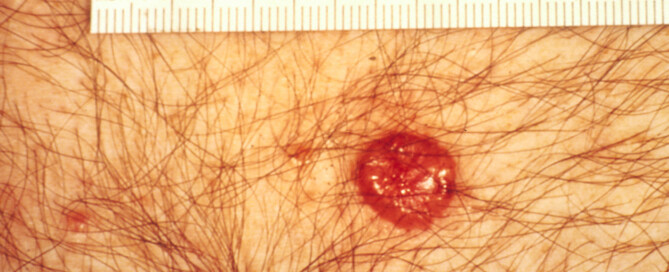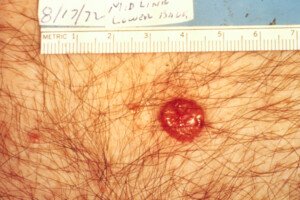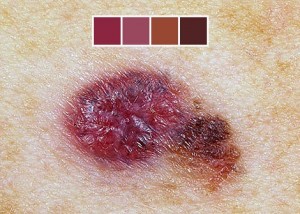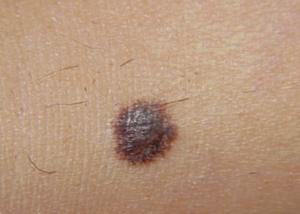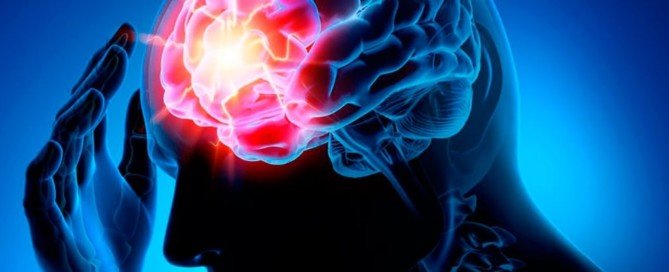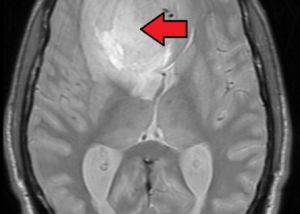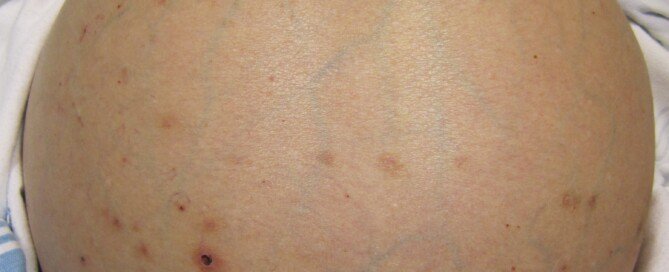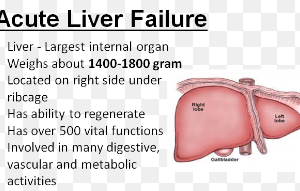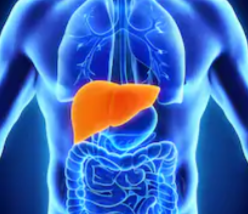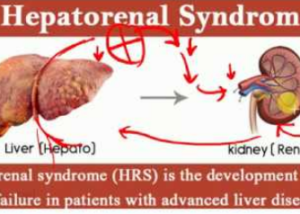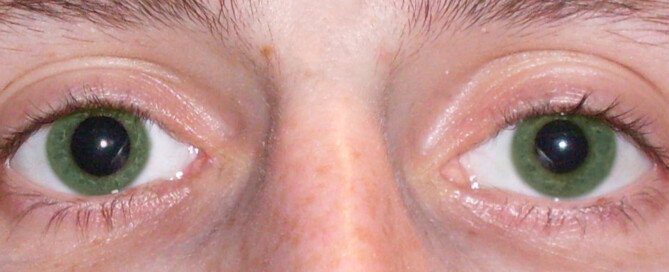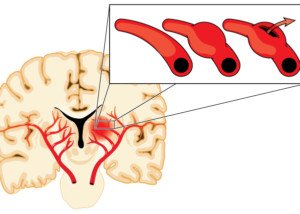Can People Ever Smell Skin Cancer?
Have you been sniffing at that strange mole or patch on your skin to see if you could smell something odd that might mean cancer?
Melanoma produces a distinctive odor that some dogs can detect. But can a person? (more…)
What’s the Biggest that Melanoma In Situ Can Grow?

Melanoma in situ is the earliest stage of this skin cancer, and it will often spread out before it goes deep.
So what’s the biggest an in situ melanoma of the superficial spreading type can actually grow while still remaining in this stage 0 phase?
There are many kinds of melanoma. The most commonly diagnosed, by far, is the superficial spreading type.
In this type, the tumor increases in diameter in a two-dimensional plane before it begins vertically burrowing below the top layer of skin.
The increase in diameter can occur for quite some time before the tumor begins penetrating the dermis, which is the second layer of skin below the epidermis.
“The size of the melanoma can range up to 6.5 mm or more, and if left untreated, it can grow from there and possibly spread to other parts of the body,” says Dr. Gretchen Frieling, MD, Triple Board Certified Boston Area Dermatopathologist.
A Study Investigated just How Big an In Situ Melanoma Can Get
The journal Cancer (vol. 91, issue 5) describes an investigation involving stage zero melanoma — which has a 10 year survival rate of 99 percent.
The study involved three groups of patients who were diagnosed with in situ melanoma.
They were divided into three groups according to the size of the stage 0 tumor:
• Equal to or under five millimeters
• Bigger than five millimeters but less than 10 millimeters
• Larger than 10 millimeters
So according to this study, melanoma in situ can actually grow to over 10 millimeters. A pencil eraser is five millimeters.
However, nobody knows exactly how long it takes for a pin-point melanoma to grow to 10 millimeters while it remains in its earliest stage.
If a mole appears suspicious in any way (increasing in size, changing in color, developing ragged edges or bumps on it), you should NOT wait to see what happens over the next several months.
It should be biopsied immediately. Dr. Frieling says, “The goal with any cancer or illness is to detect and treat as soon as possible.”
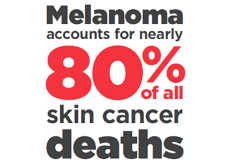
 Dr. Frieling’s website is gfacemd.com. In addition to 15+ years of experience in dermatology and dermapathology, Dr. Frieling provides advanced micro-enhancement techniques to optimize the health and beauty of her patients’ skin.
Dr. Frieling’s website is gfacemd.com. In addition to 15+ years of experience in dermatology and dermapathology, Dr. Frieling provides advanced micro-enhancement techniques to optimize the health and beauty of her patients’ skin.
 Lorra Garrick has been covering medical, fitness and cybersecurity topics for many years, having written thousands of articles for print magazines and websites, including as a ghostwriter. She’s also a former ACE-certified personal trainer.
Lorra Garrick has been covering medical, fitness and cybersecurity topics for many years, having written thousands of articles for print magazines and websites, including as a ghostwriter. She’s also a former ACE-certified personal trainer.
.
Source: onlinelibrary.wiley.com/doi/full/10.1002/1097-0142%2820010301%2991%3A5%3C992%3A%3AAID-CNCR1089%3E3.0.CO%3B2-I
Can Melanoma Grow Inside the Belly Button?

Not only can melanoma grow inside the belly button, but this particular location makes the cancer potentially more aggressive and able to spread faster than if it were, for example, located on the chest, back or leg.
“Melanoma can develop on any skin surface, even the belly button,” says Erum Ilyas, MD, a board certified dermatologist who performs adult and pediatric medical dermatology, cosmetic dermatology and skin cancer treatment with Schweiger Dermatology Group.
How common is a belly button melanoma?
“Umbilical or belly button tumors are not common,” says Dr. Ilyas.
“Cancers that metastasize to the belly button from internal cancers (gynecological, gastrointestinal, lymphoma, etc.) are actually more common than primary cancers found in the belly button.
“This type of tumor [metastatic] is called a Sister Mary Joseph nodule. In women it is most commonly metastatic from ovarian cancer and in men from gastric carcinoma.
“That being said, melanoma in the umbilicus is rare but should be checked for because it is thought that if or when it occurs, that it may be more likely to spread or metastasize quickly because the area is highly vascular and has old connections to the internal organs.”
The Dermatology Online Journal (Mangas et al) says that belly button melanomas don’t seem to be frequent, but that the “real incidence is difficult to determine due to the lack of statistics about it on the literature.”
A report by Monta et al is chilling:


What makes navel melanomas unique is that the natural creasing of the inside of a belly button can obscure a growing cancer.
Furthermore, in overweight people it’s more difficult to get a good look.
And unfortunately, not every dermatologist says during the annual skin exam, “Okay, I’m now going to inspect your belly button.”
In order for a doctor to adequately inspect it, the doctor must pry at the umbilicus in different directions to spread apart its natural folds that might be concealing a suspicious lesion. Simply hovering over it with a dermatoscope isn’t enough.
Melanoma in Belly Button Found by Accident
A report in Aesthetic Plastic Surgery (April 2013) cites the case of a woman who was under general anesthesia for a planned harvesting of fat from her abdominal area for breast asymmetry contouring.
Entryway for the fat is done through the navel so that the scar can be concealed.
Before cutting, the surgeons noticed a pigmented lesion inside the belly button which had gone unnoticed during the preop exam.
The spot turned out to be a melanoma in situ that had arisen from a pre-existing mole.
 Dr. Ilyas has practiced dermatology in the Philadelphia area and Boston for 15+ years and has served as Assistant Professor of Dermatology at Drexel University College of Medicine.
Dr. Ilyas has practiced dermatology in the Philadelphia area and Boston for 15+ years and has served as Assistant Professor of Dermatology at Drexel University College of Medicine.
 Lorra Garrick has been covering medical, fitness and cybersecurity topics for many years, having written thousands of articles for print magazines and websites, including as a ghostwriter. She’s also a former ACE-certified personal trainer.
Lorra Garrick has been covering medical, fitness and cybersecurity topics for many years, having written thousands of articles for print magazines and websites, including as a ghostwriter. She’s also a former ACE-certified personal trainer.
Sources
bmcresnotes.biomedcentral.com/articles/10.1186/s13104-015-1096-x
escholarship.org/uc/item/2nm0d006
search.proquest.com/openview/0111df8b07d79c3f2865c2342c8d0bce/1?pq-origsite=gscholar&cbl=54048
Vision Blackouts, Heartbeat in Ear, Headache: Brain Condition

If you’re been suffering from blackouts, headaches and hearing your heartbeat in your ear, this could mean a serious brain condition.
In fact, just one of these symptoms can be caused by something serious affecting your brain. (more…)
Ascites, Jaundice, Mental Impairment in Chronic Heart Failure

Suppose an elderly person with chronic heart failure starts getting ascites and suddenly develops jaundice and change in mental status.
The triad of ascites, jaundice and visible ascites (even mild) is often associated with cirrhosis of the liver caused by excessive alcohol consumption. (more…)
Pain in One Eye with Movement: Brain Tumor? Aneurysm?

If you have pain in one eye when you move it, this can have many causes and unfortunately, two can be a brain tumor or an aneurysm. (more…)
Blurry Vision that Alternates Eyes: Tumor, TIA, Dry Eye?

If you’ve been experiencing blurry vision that alternates eyes, what are the odds that this could be caused by a tumor or transient ischemic attack, vs. a more benign cause? (more…)
Hearing Every Tiny Movement of One Eyeball: Causes & Solutions

If you’ve been hearing your eyeballs move — does this mean you’ve gone bonkers?
Or is this an actual phenomenon that’s recognized by doctors?
It Has a Name
“Hearing every tiny movement of your eyeball is called autophony,” says Kaushal M. Kulkarni, MD, board certified ophthalmologist and neuro-ophthalmologist in private practice in New York.
The term “autophony” translates to one’s self being the only person who can hear something going on with their body.
When the sound seems to be coming from inside an ear, it has a more specific name: tinnitus.
But hearing the movements of one eyeball is certainly not unheard of in the medical world.
Cause of Hearing an Eyeball Move
This can be a most bothersome symptom that’s difficult to escape from, since we have to move our eyes in day to day life.
“This is most commonly caused by a condition called superior canal dehiscence syndrome,” continues Dr. Kulkarni.
“This is a rare disorder of the inner ear caused by a thinning or complete absence of a part of the overlying temporal bone.
“It is usually something you are born with, or could occur after trauma.
“In addition to hearing your eyeballs moving, you may hear your own voice as disturbingly loud and distorted, creaking and cracking of your joints, the sound of your footsteps when walking or running, your heartbeat in your ear (pulsatile tinnitus).”
Superior Canal Dehiscence Syndrome
SCD can also cause problems with balance and hearing. Dehiscence refers to an opening in a bone.
In addition to hearing one’s eyeball move, SCD can also make a person hear their eyelids blink.
There actually is nothing wrong with the eyeball itself. It’s just that SCD “amplifies” the sounds created by the tiny movements of the body.
Treatment
The treatment specialist would ideally be a certified vestibular physical therapist, even though the diagnosis would be made by a medical doctor.
If hearing one’s eyeball moving around or lids blinking is unbearable and impossible to habituate to, the patient can discuss surgical plugging of the dehiscence with their doctor.
 Dr. Kulkarni specializes in providing refined medical and surgical eye care, and has a special interest in optic nerve regeneration. He completed subspecialty training in neuro-ophthalmology at the prestigious Bascom Palmer Eye Institute in Miami, FL.
Dr. Kulkarni specializes in providing refined medical and surgical eye care, and has a special interest in optic nerve regeneration. He completed subspecialty training in neuro-ophthalmology at the prestigious Bascom Palmer Eye Institute in Miami, FL.
 Lorra Garrick has been covering medical, fitness and cybersecurity topics for many years, having written thousands of articles for print magazines and websites, including as a ghostwriter. She’s also a former ACE-certified personal trainer.
Lorra Garrick has been covering medical, fitness and cybersecurity topics for many years, having written thousands of articles for print magazines and websites, including as a ghostwriter. She’s also a former ACE-certified personal trainer.
.
Top image: Freepik.com, master1305
Headache Pain When Moving Both Eyes: Can Be Emergency Condition
Do you feel headache pain whether you move your eyes right, left, up or down?
Under certain circumstances this can mean an emergency situation. (more…)
One Pupil Is Dilated, Cheek Tingling: Likely Causes


